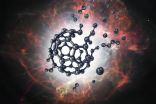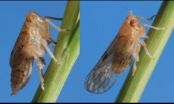Buckyballs become bucky-bombs
New creation could one day be used for demolition of cancer cells
2015-03-18
(Press-News.org) In 1996, a trio of scientists won the Nobel Prize for Chemistry for their discovery of Buckminsterfullerene - soccer-ball-shaped spheres of 60 joined carbon atoms that exhibit special physical properties.
Now, 20 years later, scientists have figured out how to turn them into Buckybombs.
These nanoscale explosives show potential for use in fighting cancer, with the hope that they could one day target and eliminate cancer at the cellular level - triggering tiny explosions that kill cancer cells without affecting surrounding tissue.
"Future applications would probably use other types of carbon structures - such as carbon nanotubes, but we started with Bucky-balls because they're very stable, and a lot is known about them," said Oleg V. Prezhdo, professor of chemistry at the USC Dornsife College of Letters, Arts and Sciences and corresponding author of a paper on the new explosives that was published in the Journal of Physical Chemistry on February 24.
Carbon nanotubes, close relatives of bucky-balls, are used already to treat cancer. They can be accumulated in cancer cells and heated up by a laser, which penetrates through surrounding tissues without affecting them, and targets carbon nanotubes directly. Modifying carbon nanotubes the same way as the buckybombs will make the cancer treatment more efficient - reducing the amount of treatment needed, Prezhdo said.
To build the miniature explosives, Prezhdo and his colleagues attached 12 nitrous oxide molecules to a single Bucky-Ball and then heated it. Within picoseconds, the Bucky-Ball disintegrated -- increasing temperature by thousands of degrees in a controlled explosion.
The source of the explosion's power is the breaking of powerful carbon bonds, which snap apart to bond with oxygen from the nitrous oxide, resulting in the creation of carbon dioxide, Prezhdo said.
INFORMATION:
Prezhdo collaborated with co-corresponding author Vitaly V. Chaban, who was at USC when the research was completed and is now at the Universidade Federal de São Paulo in Brazil with fellow co-corresponding author Eudes Eterno Fileti.
This research was funded by the São Paulo Research Foundation; the Brazilian National Council for Scientific and Technological Development; the U.S. Department of Energy (grant DE-SC0006527); and the Russian Science Foundation (project No. 14-43-00052).
The study can be found online at: http://pubs.acs.org/doi/abs/10.1021/acs.jpclett.5b00120
[Attachments] See images for this press release:

ELSE PRESS RELEASES FROM THIS DATE:
2015-03-18
BLOOMINGTON, Ind. -- An Indiana University cognitive scientist and collaborators have found that posture is critical in the early stages of acquiring new knowledge.
The study, conducted by Linda Smith, a professor in the IU Bloomington College of Arts and Sciences' Department of Psychological and Brain Sciences, in collaboration with a roboticist from England and a developmental psychologist from the University of Wisconsin-Madison, offers a new approach to studying the way "objects of cognition," such as words or memories of physical objects, are tied to the position ...
2015-03-18
For generations, students have been taught the concept of "ecological succession" with examples from the plant world, such as the progression over time of plant species that establish and grow following a forest fire. Indeed, succession is arguably plant ecology's most enduring scientific contribution, and its origins with early 20th-century plant ecologists have been uncontested. Yet, this common narrative may actually be false. As posited in an article published in the March 2015 issue of The Quarterly Review of Biology, two decades before plant scientists explored the ...
2015-03-18
Tirat Carmel, Israel - March 19, 2015 - MeMed, Ltd., today announced publication of the results of a large multicenter prospective clinical study that validates the ability of its ImmunoXpert in-vitro diagnostic blood test to determine whether a patient has an acute bacterial or viral infection. The study enrolled more than 1,000 patients and is published in the March 18, 2015 online edition of PLOS ONE. Unlike most infectious disease diagnostics that rely on direct pathogen detection, MeMed's assay decodes the body's immune response to accurately characterize the cause ...
2015-03-18
The most extensive land-based study of the Amazon to date reveals it is losing its capacity to absorb carbon from the atmosphere. From a peak of two billion tonnes of carbon dioxide each year in the 1990s, the net uptake by the forest has halved and is now for the first time being overtaken by fossil fuel emissions in Latin America.
The results of this monumental 30-year survey of the South American rainforest, which involved an international team of almost 100 researchers and was led by the University of Leeds, are published today in the journal Nature.
Over recent ...
2015-03-18
Messenger RNAs (mRNA) are linear molecules that contain instructions for producing the proteins that keep living cells functioning. A new study by UCL researchers has shown how the three-dimensional structures of mRNAs determine their stability and efficiency inside cells. This new knowledge could help to explain how seemingly minor mutations that alter mRNA structure might cause things to go wrong in neurodegenerative diseases like Alzheimer's.
mRNAs carry genetic information from DNA to be translated into proteins. They are generated as long chains of molecules, but ...
2015-03-18
Many people in the UK feel a strong sense of regional identity, and it now appears that there may be a scientific basis to this feeling, according to a landmark new study into the genetic makeup of the British Isles.
An international team, led by researchers from the University of Oxford, UCL (University College London) and the Murdoch Childrens Research Institute in Australia, used DNA samples collected from more than 2,000 people to create the first fine-scale genetic map of any country in the world.
Their findings, published in Nature, show that prior to the mass ...
2015-03-18
DURHAM, N.C. -- Each year, rice in Asia faces a big threat from a sesame seed-sized insect called the brown planthopper. Now, a study reveals the molecular switch that enables some planthoppers to develop short wings and others long -- a major factor in their ability to invade new rice fields.
The findings will appear Mar. 18 in the journal Nature.
Lodged in the stalks of rice plants, planthoppers use their sucking mouthparts to siphon sap. Eventually the plants turn yellow and dry up, a condition called "hopper burn."
Each year, planthopper outbreaks destroy hundreds ...
2015-03-18
Researchers have linked antibiotic resistance with poor governance and corruption around the world.
Lead researcher Professor Peter Collignon from The Australian National University (ANU) School of Medicine said the increase in antibiotic-resistant infections was one of the greatest threats facing modern medicine.
In the United States alone, around 23,000 deaths and two million illnesses each year have been attributed to antibiotic-resistant bacteria.
"We found poor governance and higher levels of corruption are associated with higher levels of antibiotic resistance," ...
2015-03-18
COLUMBUS, Ohio - Cardiovascular researchers at The Ohio State University Wexner Medical Center have shown that a protein known as MG53 is not only present in kidney cells, but necessary for the organ to repair itself after acute injury. Results from this animal model study are published in the journal Science Translational Medicine.
Previous work by Jianjie Ma, a professor and researcher in Ohio State's Department of Surgery and the Dorothy M. Davis Heart & Lung Research Institute, identified and proved that MG53 repairs heart, lung and skeletal muscle cells as well.
"MG53 ...
2015-03-18
Although bike-sharing systems have attracted considerable attention, they are falling short of their potential to transform urban transportation.
A new study by University of Chicago Booth School of Business Assistant Professor Elena Belavina, INSEAD Professor of Sustainable Development Karan Girotra and INSEAD Ph.D. candidate Ashish Kabra found that it is possible for cities to increase ridership without spending more money on bikes or docking points -- simply by redesigning the network.
The researchers spent four months in Paris observing the Velib' bike-share system ...
LAST 30 PRESS RELEASES:
[Press-News.org] Buckyballs become bucky-bombs
New creation could one day be used for demolition of cancer cells



